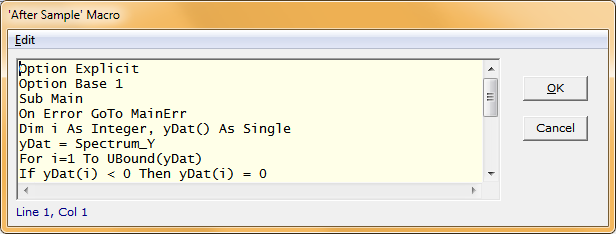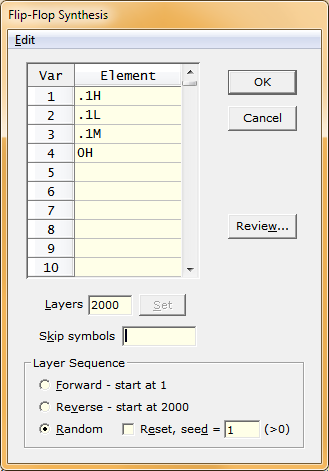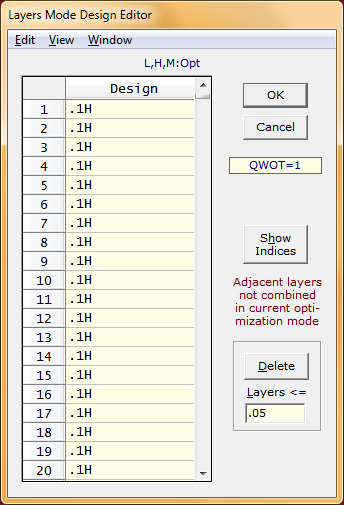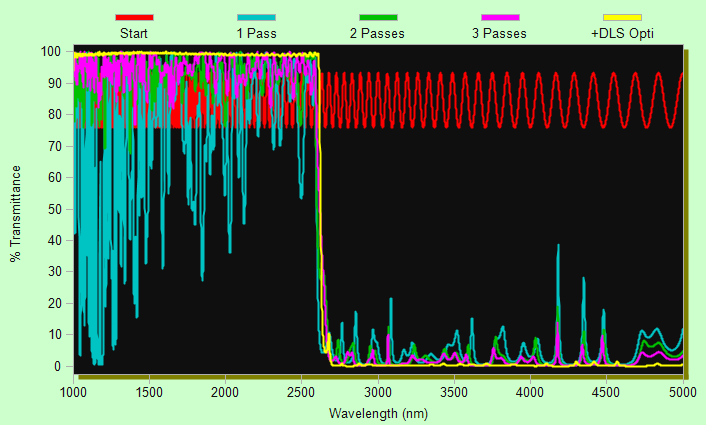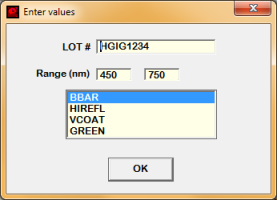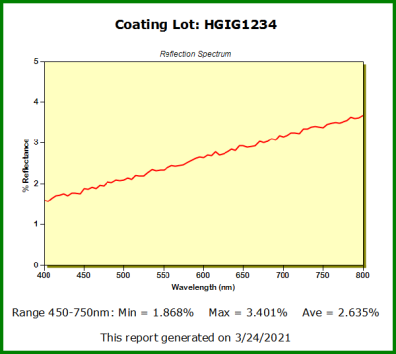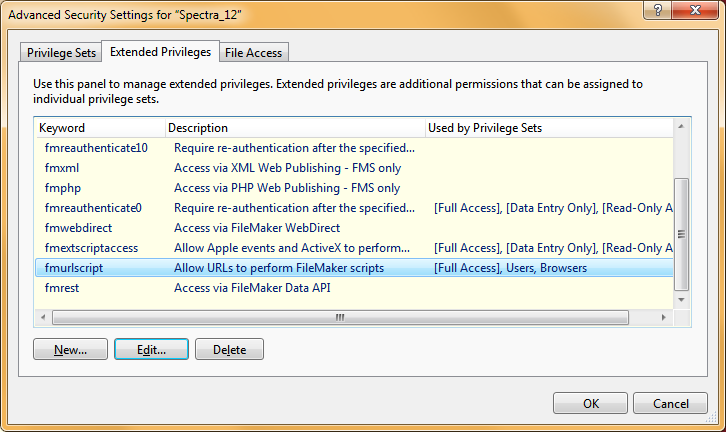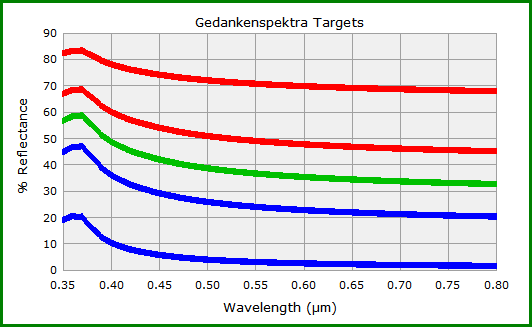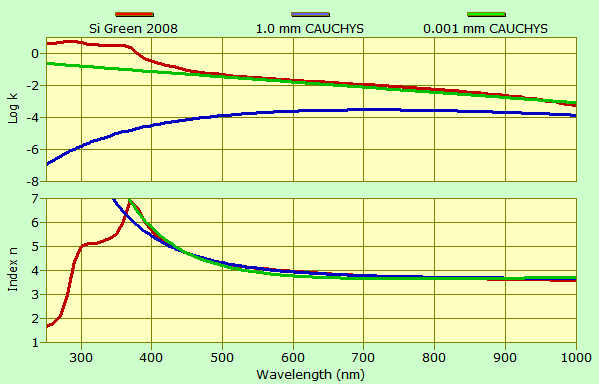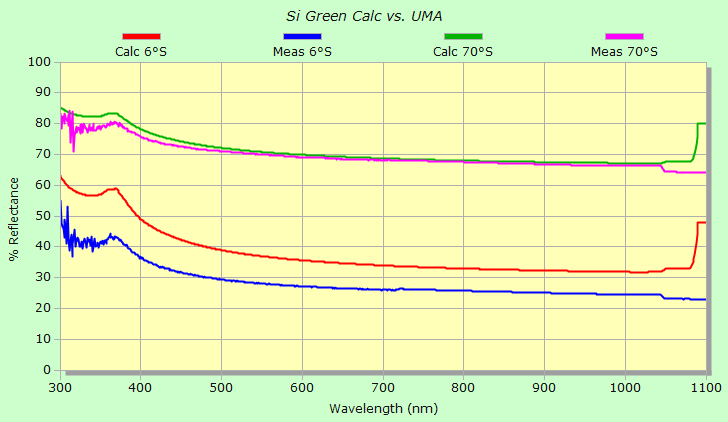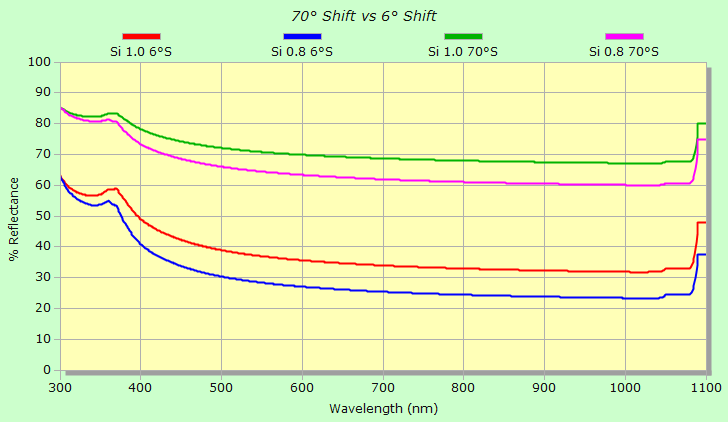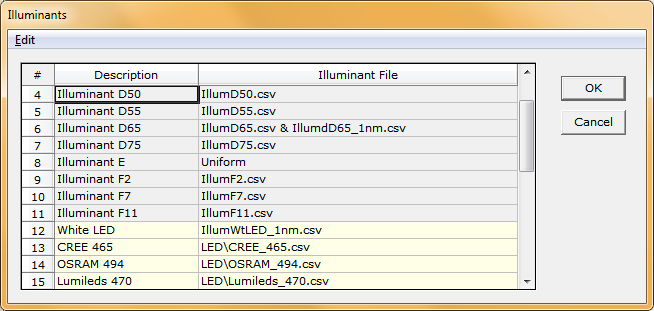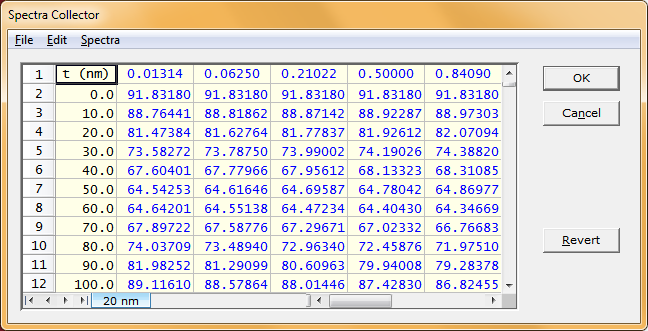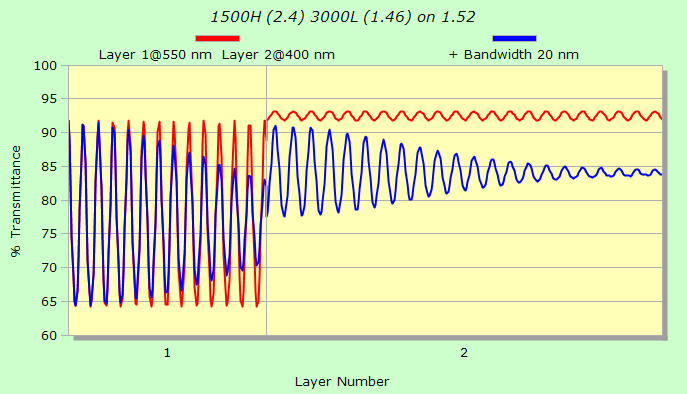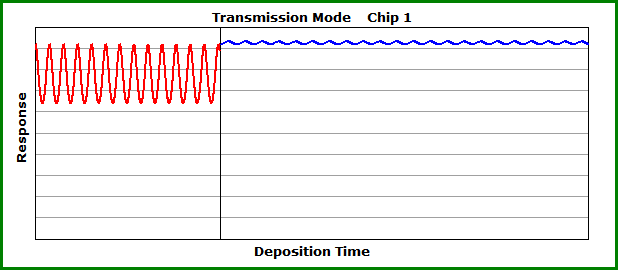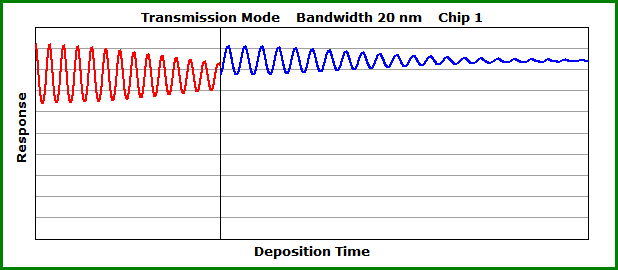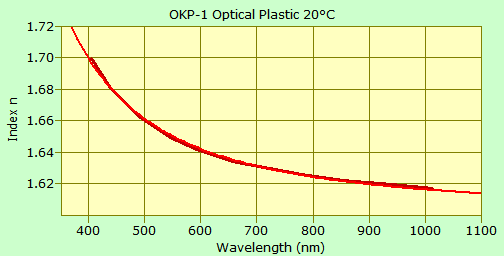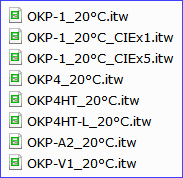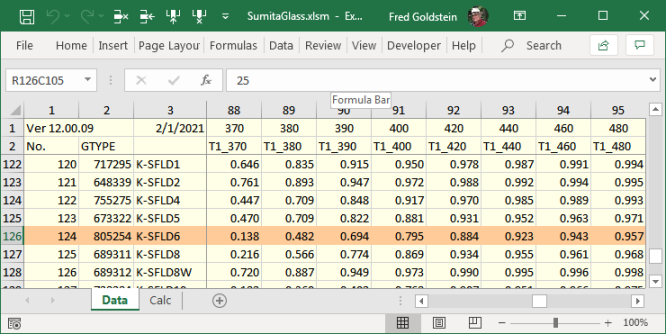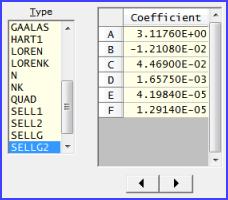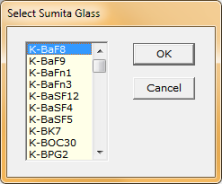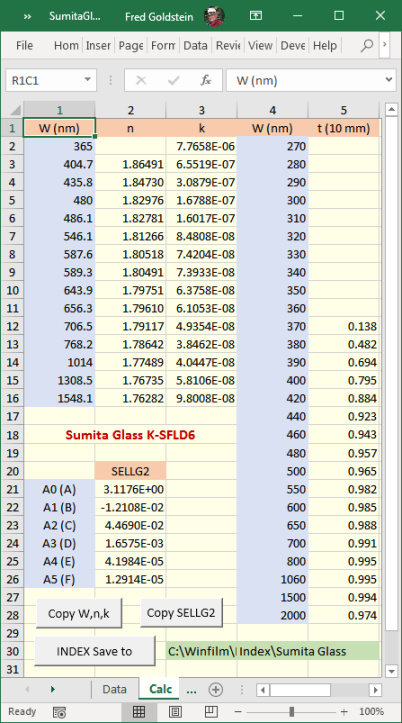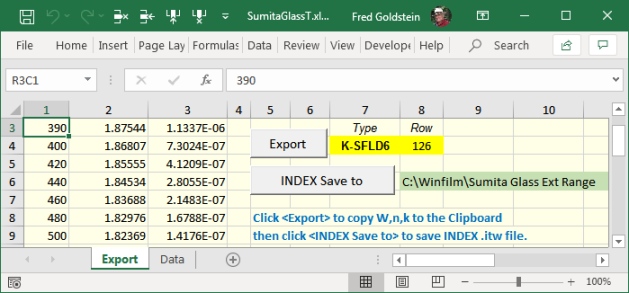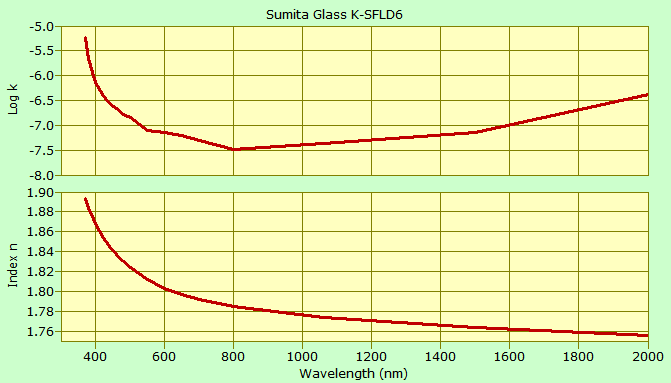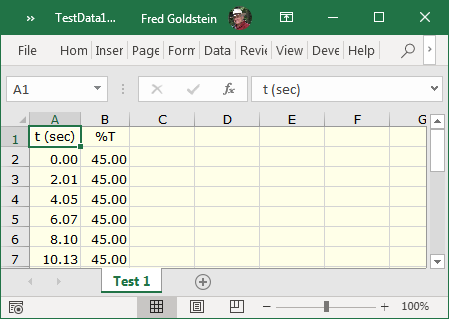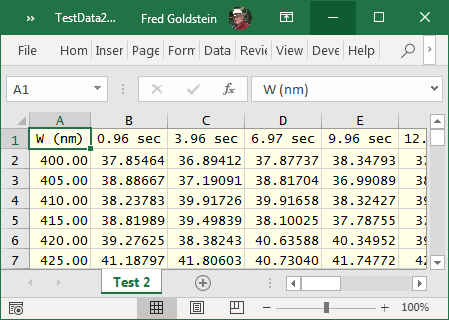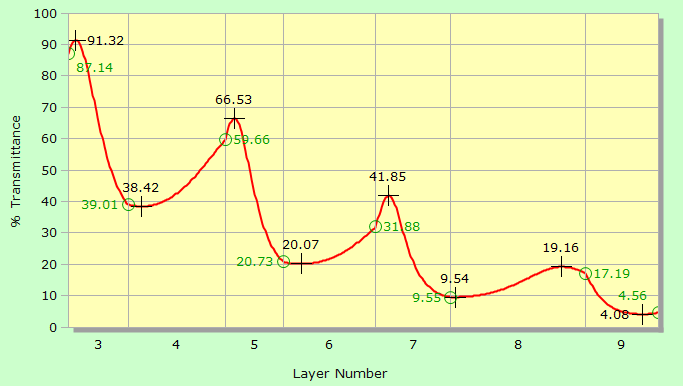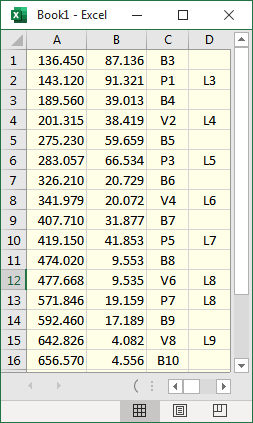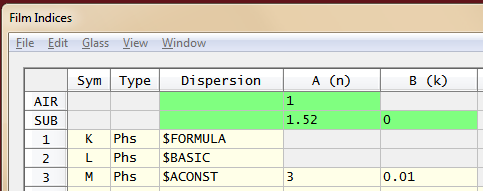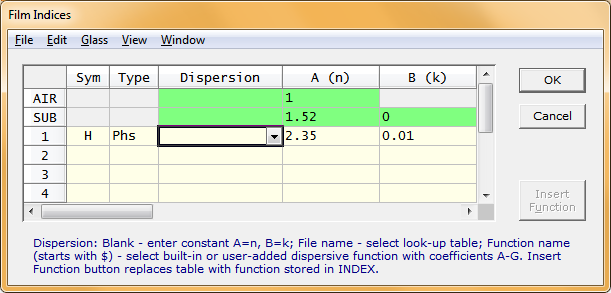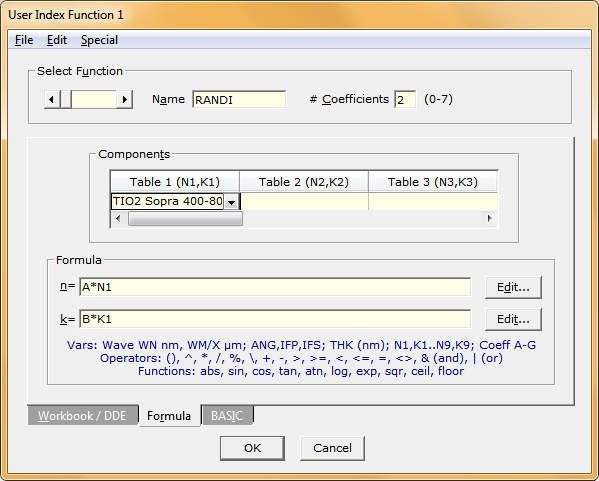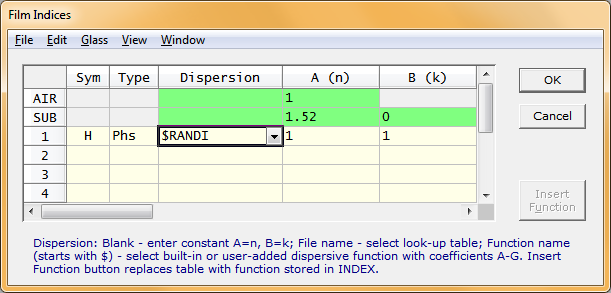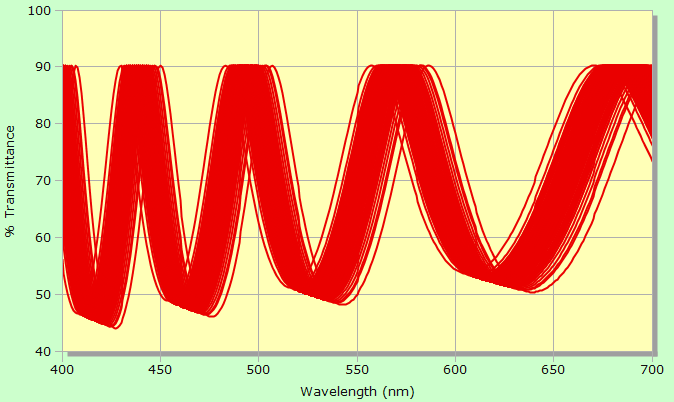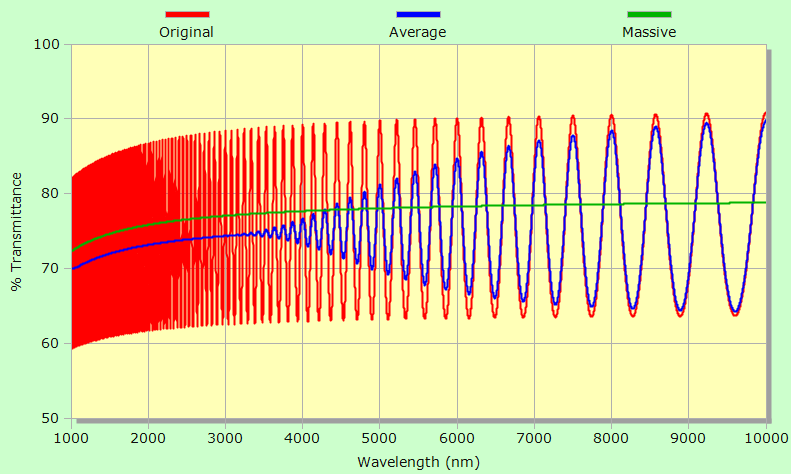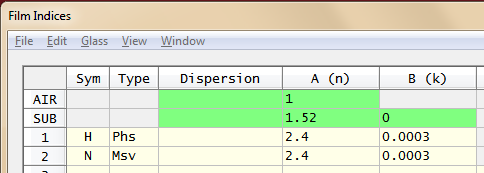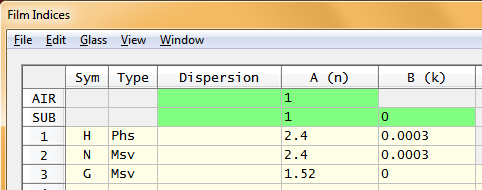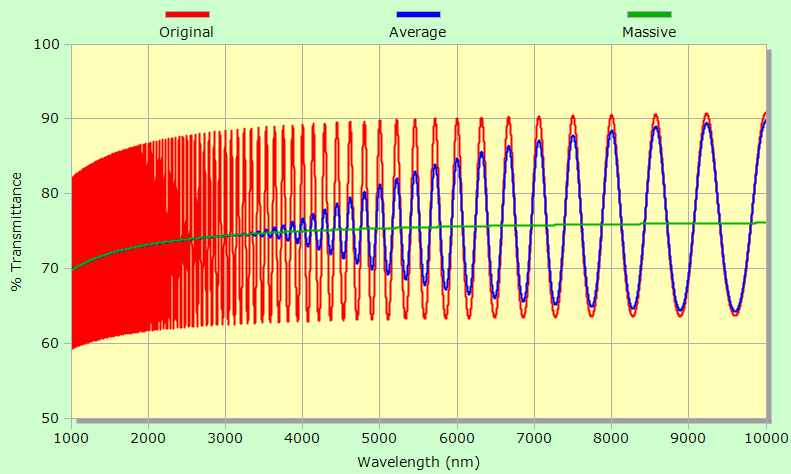|
Technical Issues - FilmStar News 2021 Other editions:
2006, 2007, 2008,
2009, 2010,
2011, 2012 January 4 Negative Spectral Values A user reported difficulties with FilmStar BASIC code that exports MEASURE spectra to the LBL Window (as in window glass) application. The problem is that Window cannot deal with negative data values resulting from spectrometer noise. One possible solution is the BASIC code listed below.
Automate the procedure by assigning it to the After Sample Scan Macro:
BASIC code can also be embedded directly into (and saved with) the Scan Method:
Embedding code is more reliable. Note that version 2.51.2010 adds Edit.. Run Code <F9> in addition to Edit.. Edit Code <F5> as shown below.
February 25 Flip-Flop Lowpass Example Users rarely ask about DESIGN's Flip-Flop
capability, so it seems a good time for a detailed example.
As shown below, results are encouraging.
March 24 QA Report Example A MEASURE user needs to enter data and generate reports. A worked example illustrates main points. For additional explanation, please refer to tutorials FilmStar BASIC and Report Generator.
A minor modification enables code to work in DESIGN and MEASURE/Scantraq. Users lacking MEASURE can test in DESIGN and consider how to accomplish the same in their current data acquisition software, e.g. UV Winlab. 1. MEASURE/Scantraq version (as downloaded):
2. DESIGN modification:
One way to implement BASIC code in MEASURE is through an After Sample Scan Macro. As shown, the entire macro can be embedded and saved with the Scan Method.
Please contact FTG Software with questions and help with modifications meeting particular requirements. April 7
FileMaker Pro Update (FilmStar Database) FileMaker can trigger scripts via URL commands. We have replaced ActiveX scripting (problematic in FM 19) with FilmStar BASIC function OpenURL and Excel VBA function ShellExecute. Downloads:
1. FilmStar users with current Database
installation password:
FM12Setup.exe.
If currently using the FilmStar Database, previous ActiveX-based code is easily modified for URL scripting. DESIGN 2.61.4580 or MEASURE 2.51.2030 is required. Contact FTG Software if any issues.
A free FileMaker 19 trial (Windows 10 required) is available. As shown below, be sure to add fmurlscript to Advanced Security Settings. fmextscriptaccess can be cleared since ActiveX is no longer utilized. According to the FileMaker website, URL scripting was added in Version 12. We were able to test 14, 17-19.
The Excel workbooks have been tested in Windows 10 (32-bit Excel, FileMaker 19) and in Windows 7 (32-bit and 64-bit Excel, FileMaker 18). If you get a File not found error; try again. You may also need to ensure that you are able to write to C:\Windows\Temp. Contact FTG Software if you can't get the examples to work. May 25 Si Wafer n&k Gedanken Analysis A researcher purchased a Cary UMA
spectrophotometer hoping that reflectance measurements would lead to a
Standard Operating Procedure (SOP) for n&k determination for visible
films on Si wafers. In a previous study
we analyzed the researcher's Si3N4 films on Si.
Running the code and converting to optimization targets gives the following (red S pol, blue P pol).
Fitting CAUCHYS for a 1 mm substrate, we obtain reasonable results for n, but not k (blue trace). Explanation: For k to affect reflectance (assuming k<<n), light must pass through the substrate and be reflected from the second surface. If the substrate is too thick, no light is reflected from the second surface. As shown below, we obtain correct k values above 400 nm for 0.001 mm substrates but poor agreement for 1.0 mm. (You might want to convince yourself that a 1000 µm substrate is thick enough to suppress fringes.) Ultimately there is a point at which increasing k results in metallic behavior. We leave that as a subject for a future edition of the FilmStar News!
A possible glitch is revealed below. Note the considerable difference between 6° calculated and measured spectra, but surprisingly little difference at 70°.
Is it possible that differences disappear at high angle? In the graph below we implement User-Defined Index Function n = A*N1, k = K1 where N1,K1 indicate Si look-up tables. Coefficient 'A' varies from 1.0 to 0.8 giving the difference between the red and blue traces. As indicated in the magenta and green traces, a difference remains at 70°. This suggests a possible issue with the user's WinUV UMA measurement technique and points out the need to examine and contemplate spectra prior to computer analysis.
June 1 Illuminants Editor A user requires LED illuminants. As this necessitated editing Design1.ini or Measure.ini in ..Winfilm\Config we realized that the procedure could be simplified. We therefore implemented an Illuminants dialog accessed in the CIE Color module (<Ctrl+F9>) with Edit...Illuminants (<Ctrl+I>).
The first 11 rows refer to illuminants installed
by Setup32. Any modifications to rows 1-11 are ignored, as can be
verified by clicking <OK> and reopening the dialog. Click Edit...Add
Illuminant (<Ctrl+A>) to add or modify rows 12 through 31.
Most importantly, each illuminant file is a
single column of normalized (range 0 to 1) intensity with either 81 (380
to 780 nm x5 nm) or 401 (380 to 780 x1 nm) rows. Notes: Use Excel to verify row count
and normalize (range 0 to 1) if necessary.
Note how BASIC Sub SetIlluminant works with user-defined illuminants as in
giving ..White LED.. in the Immediate window. June 10 Bandwidth Compensation in R/T vs Thickness Spectra A FilmStar user with an Excel VBA-DESIGN model for
optical monitor strategy needs to compensate for nonzero monochromator
bandwidth. This is now implemented (DESIGN 2.61.4640) with new
Collector
BASIC function CollectAvg where weighting values (0 to 1) are
placed in Row 1. Averaging is also available in Collector menu command Spectra..
Weighted Average.
The Collector in our example is shown below. Blue text indicates calculated as distinct from measured spectra. While the Collector was initially developed for multi-angle data acquisition (UMA, ARTA/TAMS, Photon RT), it was readily modified for monitor simulation.
CollectAvg places spectra in memory for plotting or analysis. For illustration purposes we utilize thick films (layers in nm) and wide bandwidth. While thin layers may not be appreciably affected, the capability should interest filter manufacturers as well as those fabricating IR coatings with visible monitoring. Ultimately there are filters requiring laser monitoring.
Note the agreement with FilmStar MONITOR:
July 12 OKP Optical Plastic A FilmStar user requested OKP-1 dispersion files. Manufacturer Osaka Gas Chemicals kindly supplied data in PDF format which we converted to Excel tables.
Since the minimum wavelength is 404.6 nm, an error message is triggered when performing CIE color calculations (range 380 to 780 nm):
The error is avoided by replacing look-up table OKP-1_20°C with built-in dispersive function $LOREN.
You can also use Functions.. Create Table in INDEX to create tables from 380 to 780 nm x5 or x1 nm. In the graph below the heavier line is original data while the thinner line is the $LOREN function.
July 21 Sumita Optical Glass A FilmStar user, commenting on the July 12 FilmStar News topic (above), asked about Sumita Glass. We found complete glass data on the Sumita Download Page and added VBA macros and command buttons to simplify exporting data in useable form. The worksheet shown below has over 150 columns: quite a chore to manually extract optical coating data. Click here to download SumitaGlass.xlsm.
In the above, wavelengths
correspond to refractometer wavelengths (365, 404.7, etc.) with
k obtained by interpolation at those wavelengths. Since
transmittance measurements are performed over a wider range
(270-2000), it seems better to compute n with the Sellmeier
formula. We assume extrapolation is accurate over the given
wavelength intervals.
Index n shows Sellmeier function ($SELLG2) values computed at the wavelengths utilized in transmittance measurements. The FilmStar installer creates directory ..\Winfilm\Index\Sumita Glass based on 3-10 mm t values. Please advise FTG Software about any issues. August 19 Scanning vs. Time (Time Series) At first it appears that FilmStar
MEASURE (Scantraq) does not support Time Series (repeated scans over a
time interval). Digging deeper however, we see it easily implemented
with Excel XLS/XLSX output (far more useful than CSV/TXT or similar text
formats provided in instrument manufacturers' software). 1. XL functions...Time Series at single or multiple wavelengths:
A second XL functions example (temperature controller simulation) can be found here. 2. Collector...Time Series over a wavelength range:
While the above solutions do not require Excel, another (somewhat more complex) option is to send data directly to Excel. Users requiring assistance in implementing FilmStar/Scantraq BASIC should contact FTG Software for an online tutorial. Your company and career will benefit! September 14 Cicadas Inspire Optical Technology
Wang et al. provide an equation (#4) for the effective refractive index
nEff of a cicada substrate. This is readily implemented in
FilmStar as
User-Defined Index Function
$NEFF=SQR(A+(1-A)*N1^2) where
N1 is substrate index and A the proportion of air and substrate
materials. October 5 Peaks in %R/%T vs. Thickness Plots A not well known DESIGN feature is its
ability to compute peaks and valleys in R/T vs. thickness
graphs. This was added for
monitoring with a flip fixture wherein coatings are deposited on
both sides of the substrate and the more convenient
FilmStar MONITOR cannot be utilized.
NOTE: Discrepancies
reported in thick designs were addressed in 2.61.4671 (Oct 14).
November 11 Index Formulator vs. BASIC An advanced DESIGN user required
assistance with setting up complex dispersion equations. This
inspired us to review and compare dispersion functions in the
Index
Formulator and FilmStar BASIC. It is interesting to note
that the equations were too complex for Excel VBA, but worked in
FilmStar. Curious indeed!
In the above case Index Coefficients (as displayed in the Film Indices dialog) are not utilized. That possibility is displayed below for NKTest.faw.
To test, download and extract NKTest.zip. Copy *.bas to C:\Winfilm\Basic32. (NKTest.itf is the Collection of index functions [File.. Open Collection] in case functions get 'lost'.) Note that DESIGN 2.61.4674 and INDEX 2.51.0683 are required. Try changing the design from 200K to
200L to 200M, etc. (200K and 200L should match.) Problems? Send
data files enabling us to duplicate your issue. Screen images
alone are often insufficient. Be prepared for a
ZOOM session
if necessary. November 22 Tolerancing with Index Variations In DESIGN tolerancing we
simulate errors arising from random thickness variations. A user
recently asked about varying indices. The capability is
readily implemented with BASIC and User Index Functions.
Copy the code and paste into the BASIC editor.
Dispersive materials can also be utilized. In that case we take advantage of User-Defined Index Functions. In the following we define function RANDI based on TiO2.
As shown below, columns A and B now contain index multipliers instead of n and k.
In the above BASIC code we utilized the Main Menu graphics window screen. In the code below we use the FSPlot Module wherein the light green background matches this web page. Here A and B are index multipliers, NOT actual index values.
Here's the result for design 500H (physical thickness).
Users with advanced knowledge of index variations (wavelength and/or thickness dependence) can implement more sophisticated models in the Index Formulator. Please e-mail FTG Software or call +1 609-924-6222 with any questions, issues, or comments. December 13 Massive Layers Revisited (previous discussion) We were asked about n,k determination in thick thin films (layers with multiple fringes). We propose that measured spectra be smoothed and converted to optimization targets over a wavelength range simulating a massive layer. The procedure can be implemented manually (Spectra.. Smooth Data, Spectra.. Convert Table, Optimize.. Targets.. Convert Spectrum) or automated as follows.
The Original design is 25000H (n=2.4, k=0.0003, SUB = 1.52). Average utilizes 100 nm bandwidth simulation. The massive design is 0.025N (n=2.4, k=0.0003). Error: Massive does not overlap Average below 3500 nm!
The error results from effectively calculating the massive layer with an AR on the uncoated surface while FWD Include Sd 2 (Setup.. Parameters) was utilized for Original and Average.
The correct solution is obtained by treating the substrate as a massive layer.
Users should carefully review data before refining n,k values. While the erroneous Massive curve appears reasonable at first glance (similar shape as the correct curve), it leads to incorrect solutions. Measured spectra will not be as well-behaved as the theoretical Gedankenspektrum data given above. Should spectrophotometry prove inadequate, try ellipsometry. An article (pg 34) in Dec 2021 Vacuum Coating & Technology discusses thick organic films. We invite users to report on the success or failure of the massive layer simulation method. |
Copyright © 2023 FTG Software Associates
Last updated on
March 16, 2025


